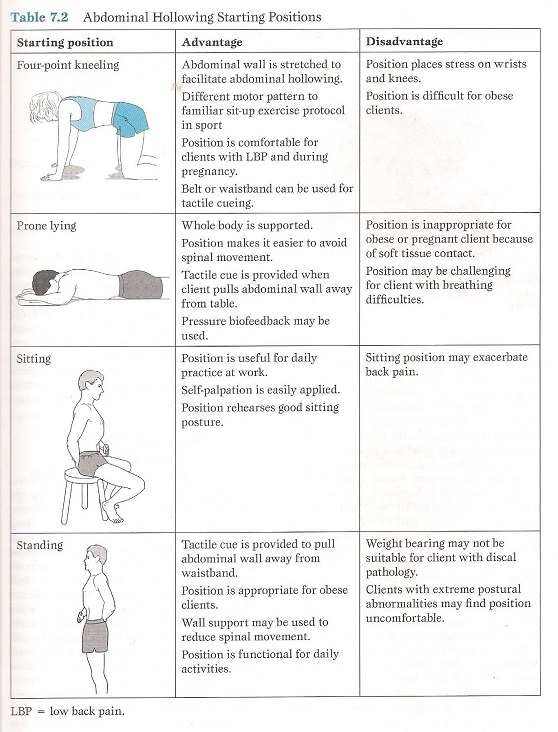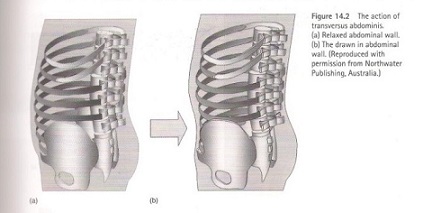Exercises for Lumbar Instability
Original Editors - Bruno Luca
Top Contributors - Laura Ritchie, Bert Lasat, Bruno Luca, Jona Van den Broeck, Denys Nahornyi, Admin, Kim Jackson, Blessed Denzel Vhudzijena, WikiSysop, Evan Thomas, Saeed Dokhnan, 127.0.0.1, Liam Butterworth and Candace Goh - Your name will be added here if you are a lead editor on this page.
Search Strategy[edit | edit source]
Instability AND lumbar spine
transversus abdominis
physiotherapy and lumbar instability
transversus abdominis low back
anatomy back
spinal stabilisation
core stability
exercises back
therapy low back pain
feedforward
Definition/Description[edit | edit source]
Low back pain can be defined as pain or discomfort in the lumbar region. This can be unilaterally of bilaterally. In 85% of the patients low back pain is non-specific. That means that there is pain without a specific medical diagnosis.
People with weak muscle strength and endurance have a great risk at low back pain. It has been shown that weak trunk extensors may lead to chronic low back pain.
Some study’s claim that overweight is also a risk factor, but not every study can prove this.Cite error: Invalid <ref> tag; name cannot be a simple integer. Use a descriptive title
Low back pain is usually due to lumbar (segmental) instability. Lumbar instability is one of the subgroups of non-specific low back pain. Implications of instability are pain, functional disability and reduced muscle endurance.Cite error: Invalid <ref> tag; name cannot be a simple integer. Use a descriptive title
Patients with lumbar instability also show a condition of loss of spinal motion segment stiffness in with normal external loads may cause pain, spinal deformity or damage to the neurological structures. Cite error: Invalid <ref> tag; name cannot be a simple integer. Use a descriptive title
Not all patients show a loss of the feedforward mechanism. But if the feedforward mechanism does not work well, the patients will have more pain. Cite error: Invalid <ref> tag; name cannot be a simple integer. Use a descriptive title
In lumbar motor control training you find more information about the feedforward mechanism.
Therapy exercises for lumbar instability is hard to define. Not only the lumbar region, but also the surrounding anatomical structures must be trained, like the abdominal muscles and some muscles of the lower extremity. The kind of exercises depends on the status of the patient.Cite error: Invalid <ref> tag; name cannot be a simple integer. Use a descriptive titleCite error: Invalid <ref> tag; name cannot be a simple integer. Use a descriptive title
Clinically Relevant Anatomy
[edit | edit source]
Clinically Relevant Anatomy of the low back.
Muscles of the low back: 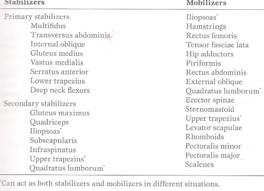
Stabilizing and mobilizing muscles that affect the low backCite error: Invalid <ref> tag; name cannot be a simple integer. Use a descriptive title
Indications for exercises[edit | edit source]
It has been showed that there are different reasons why we should give exercises to patients with lumbar instability. The most important considerations are; which are our goals and is the patient likely to benefit. An important study by Hicks et al, shows that during the examination of lumbar instability positive and negative determinants can be found indicating whether a subject will benefit from a low back stabilization program.Cite error: Invalid <ref> tag; name cannot be a simple integer. Use a descriptive title
There are indications that stabilization exercise programs are used to improve the strength, endurance, and/or motor control of the abdominal and lumbar trunk musculature. Stabilization exercise programs exist of general exercises, educational and workplace-specific back school classes, increase of workload tolerance, psychological interventions and segmental stabilization exercises. The stabilizing exercises focus on the re-education of a precise co-contraction pattern of local muscles of the spine.Cite error: Invalid <ref> tag; name cannot be a simple integer. Use a descriptive title
It had been showed that stabilizing exercises with routine exercises in reduction of pain intensity increasing the functional ability and muscle endurance. It is recommended to use stabilizing exercises in treatment of patients with lumbar segmental instability.Cite error: Invalid <ref> tag; name cannot be a simple integer. Use a descriptive title
This is the guideline about the implications for practicing the local muscle system:
• Develop the skill of an independent contraction of the local muscle synergy;
• Decrease the contribution of the overactive global muscles;
• Use a motor relearning approach to reteach the skill of developing a “corset” action of transverses abdominis and multifidus in response to the cue to draw in the abdominal wall.
• Use specific facilitation and feedback techniques to ensure each segment of the multifidus muscle is activated;
• Use specific feedback techniques to develop kinaesthetic awareness of local muscle contractions;
• Develop ability to hold the “corset” action tonically over extended periods of time
• Use repeated movements of lumbopelvic region, in non-weightbearing positions initially, to improve position sense.Cite error: Invalid <ref> tag; name cannot be a simple integer. Use a descriptive title
Implications for practice of the local muscle system with the global muscle system
• Training the local and weightbearing muscles is likely to reverse impairments in the non-weightbearing muscles;
• Initially use specific facilitation techniques for the dysfunctional weightbearing muscles, with emphasis on increasing weightbearing load cues;
• Use optimal weightbearing postures to re-establish recruitement of both the local and weightbearing muscles;
• Weightbearing muscles should be trained under the stretch from gravity in flexed and more upright postures;
• Use static weightbearing postures with increasing holds and/or very slow and controlled weightbearing exercise to enhance the feedback mechanisms;
• Increase gravitational load cues gradually, ensuring local and weightbearing muscles are responding to the increases in load;
• At a later stage it may be necessary to add in specific muscle-lengthening techniques for non-weightbearing muscles, especially if the muscle tightness is in the passive rather than the active elements of the muscle.Cite error: Invalid <ref> tag; name cannot be a simple integer. Use a descriptive title
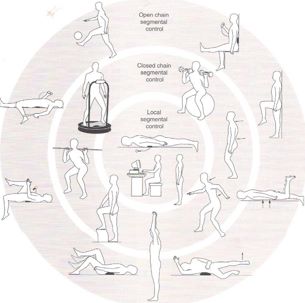
The segmental stabilization model for the prevention and treatment of low back pain Cite error: Invalid <ref> tag; name cannot be a simple integer. Use a descriptive title
The three stages of the exercise model form the building blocks for the development of the joint protection mechanisms, for both low- and high-load functional situations. Each stage includes clinical assessments of the level of impairment in the joint protection mechanisms, followed by the suggested exercise techniques.Cite error: Invalid <ref> tag; name cannot be a simple integer. Use a descriptive title
Exercise techniques[edit | edit source]
The guidline to follow before starting with exercises is to use the stabilizer. A stabilizer has come into general use for stabilization exercises for all parts of the body. A stabilizer is a pressure biofeedback unit and consists of an inelastic, three-section air-filled bag, which is inflated to fill the space between the target body area, a firm surface and a pressure dial for monitoring the pressure in the bag for feedback on position. The bag is inflated to an appropriate level for the purpose and the pressure recorded. Quite simply, movement of the body part off the bag results in a decrease in pressure, while movement of the body part into the bag results in an increase in pressure. Its use in assessing the abdominal drawing-in action has become its most important use in relation to the treatment of problems for the local muscle system in patients with low back pain. Cite error: Invalid <ref> tag; name cannot be a simple integer. Use a descriptive title
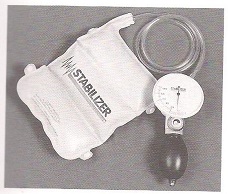 Cite error: Invalid
Cite error: Invalid <ref> tag; name cannot be a simple integer. Use a descriptive title
The patient must be placed in an initial position lying on the back with the hips and knees flexed. The feet remain flat on the floor and the arms must be held alongside the body. The stabilizer is positioned under the low back and there it measures the movements of the spine. During exercises the spine cannot make any movements. The transversus abdominis muscle must be in contraction while doing exercises and this muscle keeps the spine in the right position. On the picture below the woman is holding the feedback machine. Thereon she can see when her spine moves.Cite error: Invalid <ref> tag; name cannot be a simple integer. Use a descriptive title, Cite error: Invalid <ref> tag; name cannot be a simple integer. Use a descriptive title
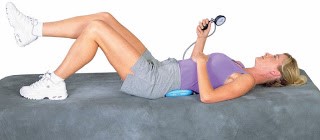 Cite error: Invalid
Cite error: Invalid <ref> tag; name cannot be a simple integer. Use a descriptive title
A. Foundation movements
1) Contracting transversus abdominis muscle.
Goal: Learns to contract the transversus abdominis muscle without contraction of the overlying abdominal muscles.
How to do?
The person pulls his belly in and up at the navel without moving the rib cage, the pelvis or the spine.
Contraction intensity: 30 to 40% of the maximum voluntary contraction ( MVC).
Building:
1) Start with a small contraction.
2)Build up the duration of the contraction.
Only when the patient can control contraction of the transversus abdominis muscle with minimal muscle intensity ( 10 repetitions each 30-40%) over a period of time , the progress should lead to more advanced exercises. Cite error: Invalid <ref> tag; name cannot be a simple integer. Use a descriptive title
A movie of this exercise is shown in spinal stabilization.
The action of the transverses abdominis : (a) relaxed abdominal wall, (b)The drawn in abdominal wall.Cite error: Invalid <ref> tag; name cannot be a simple integer. Use a descriptive title
Normally the transversus abdominis muscle is in contraction always while standing and sitting. Contraction of this muscle creates a good posture. In normal conditions the transversus abdominis muscle contract by itself, but in patients with low back pain the muscle doesn’t happen naturally. This can lead to an unstable core, which is a risk factor for low back pain.
The goal is that patients with low back pain learn to contract the transversus abdominis muscle in al times (except in lying position).
After a time the muscle shut contract naturally. It is very important in patients with low back pain that they have a good posture, that’s why they have to learn to contract the transversus abdominis muscle.Cite error: Invalid <ref> tag; name cannot be a simple integer. Use a descriptive title
2) Contract of the M. multifdus
The mucle is the most important stabilizer of the spinal extensor group. People with low back pain often lose the ability to contract this muscle and they do not regain the ability spontaneously.
How to do?
First the person learn to recognize what is feels like to tense and relax the muscle.
Second focus not only on the multifidus but also on the lateral abdominals. Cite error: Invalid <ref> tag; name cannot be a simple integer. Use a descriptive title
3) Control of the pelvic muscles
This is important to move confidently into a neutral lumbar position. People with low back pain have not the ability to perform pelvic tilting. You can see excessive flexion laxity but limited, or bloked extension.
The ability to dissociate lumbar movement form pelvic movement is therefore important, and correction of faulty lumbar-pelvic rhythm is vital. Cite error: Invalid <ref> tag; name cannot be a simple integer. Use a descriptive title
4) Diafragma
The muscles are also reduced in asociation with rapid limb movement and support surface translation while global muscle activity is increased. It may be predicted that people with respiratory disease may have increased incidence of low back pain. Cite error: Invalid <ref> tag; name cannot be a simple integer. Use a descriptive title
|
Prone kneeling Lumbar-Pelvic Rythm Cite error: Invalid
|
Goal: Facilitate active pelvic tilt. Prone kneeling with shoulders directly above the hands and hip above the knees Phase 1(a): no lumbar or pelvic movement should occur Phase 2(b):posterior pelvic tilt and hip flexion occur Phase 3(c) :Lumbar flexion and some thoracic flexion finish the action (d): Faulty lumbar-pelvic rhythm often shows up when lumbar flexion and posterior pelvic tilt occur immediately. Building: 1) The patient learns the tilting 2) The tilting has to be rhythmic Cite error: Invalid <ref> tag; name cannot be a simple integer. Use a descriptive titleThe control of the pelvic muscles is important to move confidently into a neutral lumbar position. People with low back pain don’t have the ability to perform pelvic tilting. They exhibit also a limited excessive flexion laxity or bloked extension. Cite error: Invalid <ref> tag; name cannot be a simple integer. Use a descriptive titleThe ability to dissociate lumbar movement from pelvic movement is therefore important and the correction of faulty lumbar-pelvic rhythm is vital. Cite error: Invalid <ref> tag; name cannot be a simple integer. Use a descriptive title |
High(two-point) kneeling (assisted) hip hinge action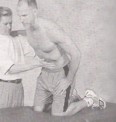 Cite error: Invalid Cite error: Invalid <ref> tag; name cannot be a simple integer. Use a descriptive title
|
Goal: Use a pelvic tilt action to move the spine forward and backward. Once you can perform pelvic tilting well, you should combine it with classic hip in a hinge action where the trunk moves on the hip in a hinge action and the spine remains straight. Avoid any increase or decrease in lumbar lordosis! Draw the abdominal muscles and maintain this minimal contraction throughout the movement! Cite error: Invalid <ref> tag; name cannot be a simple integer. Use a descriptive title |
Sitting pelvic tilt using gym ball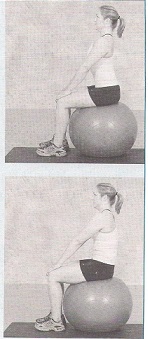 Cite error: Invalid Cite error: Invalid <ref> tag; name cannot be a simple integer. Use a descriptive title
|
Goal: Teach anterior-posterior pelvic tilt control. Sit on the ball with knees apart and feet flat on the floor. Both hips and knees should be flexed to about 90°. Tilt pelvis alternately in both anterior and posterior directions, making sure the shoulders and thoracic spine remain inactive. Start with small ranges of movement. Gradually work up to larger ranges. Cite error: Invalid <ref> tag; name cannot be a simple integer. Use a descriptive title |
Prone lying Multifidus contraction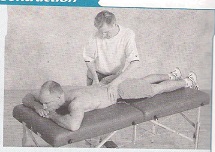 Cite error: Invalid Cite error: Invalid <ref> tag; name cannot be a simple integer. Use a descriptive title
|
Goal: Teach clients to learn to use the multifidus at will and seperately from other muscles. The multifidus is the most important stabilizer of the spinal extensor group. People with low back pain often lose the ability to contract this muscle and do not regain the ability spontaneously. Prone-lying position Therapist palplates the multifidus. Bulge the muscles beneath the fingers of the therapist and differentiate between erector spinae contraction(more lateral) and multifidus contraction(more central). To differentiate between the multifidus muscle and the erector spinae muscle, it’s recommended to contract the erector spinae muslce by hyperextend the trunk. To contract only the multifidus muscle, the patient may not hyperextend the trunk.Cite error: Invalid <ref> tag; name cannot be a simple integer. Use a descriptive titleA movie of this exercise is shown inspinal stabilization. |
Sitting Multifidus contraction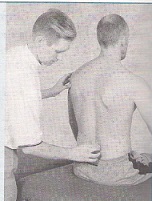 Cite error: Invalid Cite error: Invalid <ref> tag; name cannot be a simple integer. Use a descriptive title
|
Goal: Encourage your client to contract the multifidus and lateral abdominals simultaneously. Client sit on the edge of a bench with his feet on the floor. Lumbar spine in neutral position. Therapist palpates the multifidus. Client performs abdominal hollowing If the therapist feels the contraction, the client can self-palpate and continue the action for 10 repetitions, aiming to hold each for 10 s while breathing normally. Cite error: Invalid <ref> tag; name cannot be a simple integer. Use a descriptive title |
Forward stride(walk) standing multifidus contraction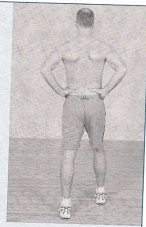 Cite error: Invalid Cite error: Invalid <ref> tag; name cannot be a simple integer. Use a descriptive title
|
Goal: Encourage your client to contract the multifidus and lateral abdominals simultaneously. Stand with one foot in front of the other Self-palpate the L4-L5 level by placing the thumbs on the lower lumbal spinosus process and moving them outward slightly into the spinal tissue. Place the weight onto the front leg and then onto the back leg alternately. Feel the muscles beneath the thumbs switching on and off. Cite error: Invalid <ref> tag; name cannot be a simple integer. Use a descriptive title |
B.Progressing stability training
Heel Slide – Basic Movement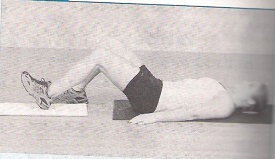 Cite error: Invalid Cite error: Invalid <ref> tag; name cannot be a simple integer. Use a descriptive title
|
Goal: Place minimal but progressive limb loading on the trunk. Slowly straighten one leg with the heel resting on the ground. The moment the pelvis anteriorly tilts and the lordosis increases, you must stop the movement and draw the leg back into flexion. Cite error: Invalid <ref> tag; name cannot be a simple integer. Use a descriptive title |
Leg Lowering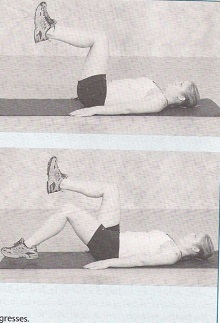 Cite error: Invalid Cite error: Invalid <ref> tag; name cannot be a simple integer. Use a descriptive title
|
This exercise is described in core stability. ‘Leg extensions’ |
Prone-Lying Gluteal Brace Cite error: Invalid Cite error: Invalid <ref> tag; name cannot be a simple integer. Use a descriptive title
|
Goal: co-contract trunk stabilizers with gluteals. Patient has to lie down and dorsiflex the toes. Flex than the knees ( 10°) and the hip (10°). After that contract the gluteal muscles. Cite error: Invalid <ref> tag; name cannot be a simple integer. Use a descriptive title |
Bridge from Crook Lying (Shoulder Bridge) Cite error: Invalid Cite error: Invalid <ref> tag; name cannot be a simple integer. Use a descriptive title
|
This exercise is described in core stability. ‘Dynamic leg and back’ |
Bridge with leg lift Cite error: Invalid Cite error: Invalid <ref> tag; name cannot be a simple integer. Use a descriptive title
|
Goal: progress from bridge from crook lying. The patient starts in crook lying ,then he lifts one leg. Avoid : allow the pelvis to fall toward the unsupported side! Cite error: Invalid <ref> tag; name cannot be a simple integer. Use a descriptive title |
Four-point Kneeling Leg movement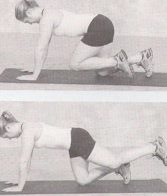 Cite error: Invalid Cite error: Invalid <ref> tag; name cannot be a simple integer. Use a descriptive title
|
This exercise is described in core stability. ‘Hamstrings raising’. |
Four- point Kneeling arm and leg lift (full bridge) Cite error: Invalid Cite error: Invalid <ref> tag; name cannot be a simple integer. Use a descriptive title
|
A movie of this exercise is shown in lumbar spine fracture. ‘Bird dog’ |
Side-Lying spine lengthening Cite error: Invalid Cite error: Invalid <ref> tag; name cannot be a simple integer. Use a descriptive title
|
Goal: control the quadratus lumborum and lateral fibers of the oblique abdominals. Start position: strong co-contraction of the abdominal muscles. Lie on one side, thighs in line with your body and flex the knees 90°. Upper body supported on the same side elbow. Straighten your spine against the force of gravity, leaving the body supported on the forearm of the underneath arm and hip. Cite error: Invalid <ref> tag; name cannot be a simple integer. Use a descriptive title |
Side-lying hip lift Cite error: Invalid Cite error: Invalid <ref> tag; name cannot be a simple integer. Use a descriptive title
|
A movie of this exercise is shown in low back pain and pelvic floor disorders. ‘Oblique abdominals’ |
Side-lying body lift(Side bridge) Cite error: Invalid Cite error: Invalid <ref> tag; name cannot be a simple integer. Use a descriptive title
|
Goal: progress from side-lying spine lengthening. Start position: side-lying spine lengthening. Lift the hips, leaving the body supported on the forearm of the underneath arm and the knees only. Cite error: Invalid <ref> tag; name cannot be a simple integer. Use a descriptive title |
Pelvic shift with leg lift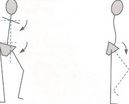 Cite error: Invalid Cite error: Invalid <ref> tag; name cannot be a simple integer. Use a descriptive title
|
Goal: teach pelvic control and stability in single-leg standing. Shift the pelvis to the left, lift slowly the right leg. The supporting leg supports the pelvis and the pelvis supports the back. Raise the knee no more than 45°.Cite error: Invalid <ref> tag; name cannot be a simple integer. Use a descriptive title |
Sitting knee raise Cite error: Invalid Cite error: Invalid <ref> tag; name cannot be a simple integer. Use a descriptive title
|
Goal: maintain pelvic positon against the pull of the hip flexors. Raise one knee, about 8 cm. Unload the limb by lifting the heel. If he is able to maintain good alignment, have him lift the entire leg. Avoid: posterior pelvic tilt! Cite error: Invalid <ref> tag; name cannot be a simple integer. Use a descriptive title |
Exercises[edit | edit source]
Before we can start teaching the patient how to use the correct muscles needed for holding the lumbar spine in a neutral position, it is important that the patient has sufficient postural awareness of the neutral lumbar position. The patient needs to maintain this neutral lumbar position during all the following exercises. These exercises can prevent problems in the lumbar region like: Lumbar instability, spondylosis, spondylolisthesis, LBP. There are two main muscles, M. Transversus Abdominis and Mm. Multifidi, which control the shape of the spine and give lateral and sagital stabilization to the spine[1] . These two muscles have connections through the thoracolumbar fascia an also have an attachment to the lumbar vertebrae. With the connection between the vertebrae, the TA and MF control the fine-tuning of the positions of adjacent vertebrae. This is also known as segmental stabilization[2] .
Contracting M. Transversus Abdominis
The first step is teaching the patient how to contract the transversus abdominis muscle by performing abdominal hollowing. In abdominal hollowing the patient pulls his belly in at the umbilicus without any movement of the rib cage, the pelvis or the spine. When you palpate closely medial of both the anterior superior iliac spines you should feel the transversus abdominis muscle contract under your fingers. When the patient has trouble contracting the correct muscle, ask him to contract his pelvic floor. This can be instructed to the patient by asking to hold his pee. Many patients will automatically contract their transversus abdominis muscle when contracting their pelvic floor. It is important that the patient does not hold his breath, but just keeps breathing in a normal way when contracting the transversus abdominis muscle [3]. Ask the patient to count out loud while doing the exercises.
When the patient is able to correctly activate his transversus abdominis muscle, he should build up muscle endurance. This can be achieved by contracting the TrA muscle at low intensity with many repetitions.
The subgoal is to:
• perform contractions with an intensity of 60% to 70% of the maximum voluntary contraction;
• hold each contraction for 10 seconds;
• perform 10 repetitions
The final goal is to:
• reduce the intensity till 30% to 40% of the maximum voluntary contraction;
• maintain the hollow abdomen position for 30 seconds.
Holding the contraction of the M. Transversus Abdominis is one of the best exercises to train the TA. To increase the effect of the exercise it is important that the TA will be trained isolated. This means that there can’t be compensatory movements of the chest or pelvic[4].
Abdominal hollowing can be performed in different starting positions depending on flexibility, weight, injury, .. of the patient. It appears that performing Abdominal hollowing maneuver in standing position and supine position can be effective on TA training[5]:
• Four-point kneeling position: Holding the contraction is easiest in this position due to the facilitory stretch of the deep abdominal muscles resulting from the forward drift of the abdominal contents.[3] The patient is placed on hands and knees, with the hip directly above the knee and the shoulder directly above the hand. Both hands and knees are shoulder-width apart. The lumbar spine is in a neutral position. The patient’s head is looking towards the floor, with the ears horizontally aligned with the glenohumeral joint. This position is comfortable for patients with low back pain or for pregnant women.
• Standing position: patient stands with his back against a wall and his feet 15 centimeters from the wall. By using a wall spinal movement can be reduced. This position is suitable for obese patients, but is not for patients with discal pathology due to the higher compression forces acting on the intervertebral discs.
• Sitting position: patient sits on a chair with a correct alignment by sitting tall. This is a useful exercise because patients can practice throughout the day. But this exercise can exacerbate low back pain in some patients. These patients will have more benefit with the four-point kneeling position.
• Prone-lying position: in prone-lying the patient pulls the abdominal wall away from the floor against the force of gravity. This is thus an exercise for those who are already able to perform abdominal hollowing. This position is not suitable for obese patients or pregnant women.
• Supine-lying position: in this position the patient is able to perceive his abdominal contraction. This exercise is also a good start for the heel slide exercise which is a more advanced exercise.
Contracting Mm Multifidi
The second step is teaching the patient how to contract the multifidus muscles in the back. This can be done with the patient in prone-lying position. While palpating paravertebral of the L4 and L5 vertebrae, ask the patient to lift up his leg or anterior tilt his pelvis. This will activate the multifidus muscles, which can be felt as a bulging underneath your fingers. Instruct the patient to focus on this contraction and memorise it. After this step, the patient should try to activate the multifidus muscles with an isometric contraction (without any movement). To achieve this, the patient needs to imagine himself performing the movement and contracting the multifidus muscles without doing the actual movement. When the patient has succeeded this exercise, he is able to tense and relax solely the multifidus muscles. The multifidus muscles should then be trained in the same way as the transversus abdominis muscle with a final goal to maintain the contraction with an intensity of 30% to 40% of the maximum voluntary contraction.
The next step is co-contraction where the local stabilizers contract at the same time to form a tight trunk. This co-contraction will then be implemented in more complex exercises with movement of the limbs. It is important that the patient learns to contract these muscles before the initial start of a movement (feedforward control).
The lumbar multifidus muscles are most active during prone lumbar extention with a full ROM and with resistance applied,
prone lumbar extension to neutral, resisted lumbar extension while sitting and prone extension with the upper and lower
extremities lifted (Superman exercise). The M. Multifidus is less active in bridging exercises[6].
The exercises for the M. Multifidus are trained at an intensity of 30% to 40% of the maximum voluntary contraction, so the bridging exercises are good exercises for the therapy for lumbar instability. When the exercises are done with an extra resistance.
• Bridging: in bridging the patient lies on the floor with the hands by their sides and the knees bend for 90°. First the patient needs to contract the TA, then tilt the pelvis into a "neutral" position and raise the pelvis off the floor. There must be a straight line through the knees - hips – shoulder.
• Bridge leg-lift: return to the bridge position and raise one leg bridging the foot off the floor.
• Bridge leg-extension: return to the bridge position and extend one leg outwards until the knee is fully extended.
All back muscles contribute in a similar way to control spine positions and movements[7][8]. It is important that the patient continue breathing during the exercise, maintains slow and controlled movements of the limbs, avoids excessive low back extension during exercises and avoids pelvic twisting during the exercises.
These stability exercises seem to have promising results. In patients radiologic diagnosed with spondylosis or spondylolisthesis stability exercises seem to have statistically significant reductions in pain and disability at a 30-month follow-up in comparison to a control group receiving usual care.[9]
Controlling the lumbar neutral position is a specific form of exercise with potential for prevention of recurrent nonspecific low back pain an disability among middle aged working men.[10]
Pilates-Based Therapeutic Exercises seem to have good results in individuals with low back pain. There is a significantly lower level of functional disability (P = .023) and average pain intensity in individuals who practice these exercises.[11]
In the research article of Roberto Gatti are some pictures of exercises used for Individuals With Chronic Low Back Pain.
Key Research / Evidence[edit | edit source]
Hayden JA, Van Tulder MW, Malmivaara AV, Koes BW. Meta-Analysis: Exercise Therapy for Nonspecific Low Back Pain. Ann Intern Med. 2005;142:765-775.
This review ment to evaluate the effectiveness of exercise therapy in adult nonspecific acute, subacute, and chronic low back pain versus no treatment and other conservative treatments.
In total 61 randomized, controlled trials were evaluated in this review. (11 acute, 6 subacute and 43 chronic low back pain).
The evidence suggests that exercise therapy is effective in chronic back pain relative to comparisons at all follow-up periods.
Some evidence suggests effectiveness of a graded-activity exercise program in subacute low back pain in occupational settings, although the evidence for other types of exercise therapy in other populations is inconsistent.
In acute low back pain, exercise therapy and other programs were equally effective.
Roberto Gatti et al[12]. showed that trunk balance exercises combined with flexibility exercises are more effective than a combination of strength and flexibility exercises in reducing disability and improving the physical component of quality of life in patients with chronic low back pain. There was a significant difference in scores on the Roland-Morris Questionnaire (P = .011) and the physical component of the 12-Item Short-Form Health Survey (P = .048) were found in favor of the experimental treatment. The experimental treatment group performed trunk balance exercises in addition to standard trunk flexibility exercises. The control group performed strengthening exercises in addition to the same standard trunk flexibility exercises.
Resources
[edit | edit source]
Christopher M. Norris. Back Stability: Integrating Science and Therapy.
Recent Related Research (from Pubmed)[edit | edit source]
Failed to load RSS feed from http://www.ncbi.nlm.nih.gov/entrez/eutils/erss.cgi?rss_guid=1tyP_Q3NRDkxDTz2n9CqJoy-eTRq__mqeGx6jtgZGegHmONQ8n|charset=UTF-8|short|max=10: Error parsing XML for RSS
References[edit | edit source]
see adding references tutorial.
- ↑ P. Vaes, Onderzoek en Behandeling Deel IIA p.103
- ↑ Stevens VK et al, The influence of specific training on trunk muscle recruitment patterns in healthy subjects during stabilization exercises. 2007 A2
- ↑ 3.0 3.1 Richardson CA, Jull GA. Muscle control-pain control. What exercises would you prescribe? Manual Therapy 1995; 1,2-10
- ↑ P. Vaes, Onderzoek en Behandeling Deel IIA p.109
- ↑ Farideh Dehghan Manshadi et al. Abdominal hollowing and lateral abdominal wall muscles’ activity in both healthy men &amp;amp;amp;amp;amp;amp;amp;amp;amp;amp;amp;amp;amp;amp; women: An ultrasonic assessment in supine and standing positions. Journal of Bodywork &amp;amp;amp;amp;amp;amp;amp;amp;amp;amp;amp;amp;amp;amp; Movement Therapies 2011. B
- ↑ RICHARD A. EKSTROM et al. Surface Electromyographic Analysis of the Low Back Muscles During Rehabilitation Exercises. journal of orthopaedic &amp;amp;amp;amp;amp;amp;amp; sports physical therapy. December 2008. (Level 1b)
- ↑ Veerle K Stevens et al, Trunk muscle activity in healthy subjects during bridging stabilization exercises. BMC Musculoskeletal Disorders 2006. B
- ↑ Cholewicki J, Van Vliet JJ 4th. Relative contribution of trunk muscles to the stability of the lumbar spine during isometric exertions. Clin Biomech (Bristol, Avon) 2002. B
- ↑ O’ Sullivan PB, Phyty GD, Twomey LT, Allison GT. Evaluation of specific stabilizing exercises in the treatment of chronic low back pain with radiologic diagnosis of spondylosis or spondylolisthesis. Spine 1997; 22:2959-67 (Level: A2; Pedro score: 7/10)
- ↑ Suni J, Rinne M, Natri A, Pasanen Statistisian M, Parkkari J, Alaranta H. Control of the lumbar neutral zone decreases low back pain and improves self-evaluated work ability. Spine 2006 Volume 31, Number 18, pp E611-E620 (Level: A2; Pedro score: 7/10)
- ↑ Rochenda Rydeard et al. Pilates-Based Therapeutic Exercise: Effect on Subjects With Nonspecific Chronic Low Back Pain and Functional Disability: A Randomized Controlled Trial. Journal of Orthopaedic &amp;amp;amp;amp;amp;amp;amp;amp; Sports Physical Therapy. July 2006. (Level B1)
- ↑ ROBERTO GATTI et al. Efficacy of Trunk Balance Exercises for Individuals With Chronic Low Back Pain: A Randomized Clinical Trial. journal of orthopaedic &amp;amp;amp;amp;amp;amp;amp;amp;amp;amp;amp; sports physical therapy. august 2011. (level 1b)
